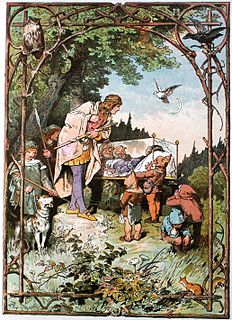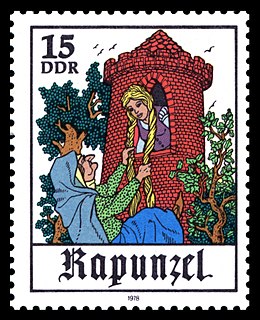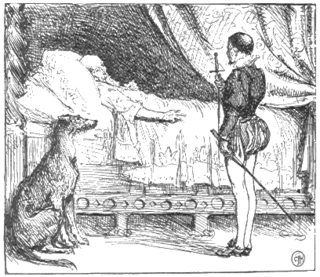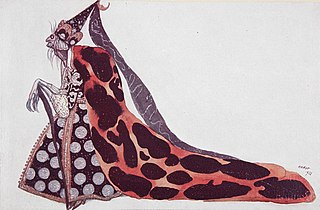Related Research Articles

"Snow White" is an 18th-century German fairy tale that is today known widely across the Western world. The Brothers Grimm published it in 1812 in the first edition of their collection Grimms' Fairy Tales and numbered as Tale 53. The original German title was Sneewittchen, a Low German form, but the first version gave the High German translation Schneeweißchen, and the tale has become known in German by the mixed form Schneewittchen. The Grimms completed their final revision of the story in 1854.

Sleeping Beauty, or Little Briar Rose, also titled in English as The Sleeping Beauty in the Woods, is a classic fairy tale about a princess who is cursed to sleep for a hundred years by an evil fairy, to be awakened by a handsome prince at the end of them. The good fairy, realizing that the princess would be frightened if alone when she awakens, uses her wand to put every living person and animal in the palace asleep, to awaken when the princess does.

Rapunzel is a German fairy tale recorded by the Brothers Grimm and first published in 1812 as part of Children's and Household Tales. The Brothers Grimm's story is an adaptation of the fairy tale Rapunzel by Friedrich Schulz (1790) that was a translation of Persinette (1698) by Charlotte-Rose de Caumont de La Force, which was itself influenced by an earlier Italian tale, Petrosinella (1634), by Giambattista Basile.

"The Goose Girl" is a German fairy tale collected by the Brothers Grimm and first published in Grimm's Fairy Tales in 1815. It is of Aarne-Thompson type 533.

"The Twelve Dancing Princesses" is a German fairy tale collected by the Brothers Grimm and published in Grimm's Fairy Tales in 1812. It is of Aarne-Thompson type 306.

"The Singing, Springing Lark", "The Singing, Soaring Lark", "The Lady and the Lion" or "Lily and the Lion" is a German fairy tale collected by the Brothers Grimm, appearing as tale no. 88.

The Iron Stove is a fairy tale collected by the Brothers Grimm, as tale number 127. It is Aarne–Thompson type 425A, the animal bridegroom. Dorothea Viehmann prepared the story for the Grimms' collection.

"The Robber Bridegroom" is a German fairy tale collected by the Brothers Grimm, tale number 40. Joseph Jacobs included a variant, Mr Fox, in English Fairy Tales, but the original provenance is much older; Shakespeare alludes to the Mr. Fox variant in Much Ado About Nothing, Act 1, Scene 1:

The false hero is a stock character in fairy tales, and sometimes also in ballads. The character appears near the end of a story in order to claim to be the hero or heroine and is, therefore, usually of the same sex as the hero or heroine. The false hero presents some claim to the position. By testing, it is revealed that the claims are false, and the hero's true. The false hero is usually punished, and the true hero put in his place.

"Trusty John", "Faithful John", "Faithful Johannes", or "John the True" is a German fairy tale collected by the Brothers Grimm and published in Grimm's Fairy Tales in 1819. Andrew Lang included it in The Blue Fairy Book.
"The Pig King" or "King Pig" is an Italian literary fairy tale written by Giovanni Francesco Straparola in his The Facetious Nights of Straparola. Madame d'Aulnoy wrote a French, also literary, variant, titled Prince Marcassin.
The Little Green Frog is a French literary fairy tale, from the Cabinet des Fées. Andrew Lang included it in The Yellow Fairy Book.
"The Riddle" is a German fairy tale collected by the Brothers Grimm in Grimm's Fairy Tales in 1819. It is of Aarne-Thompson type 851.

The Wicked Fairy Godmother or the Wicked Fairy, a rare figure in fairy tales, is nevertheless among the best-known figures from such tales because of her appearance in one of the most widely known tales, Sleeping Beauty, and in the ballet derived from it. Anonymous in her first appearance, she was later named in some variants Carabosse and is called Maleficent in Walt Disney media.
"The Twelve Huntsmen" is a German fairy tale collected by the Brothers Grimm as tale number 67 in their Grimm's Fairy Tales. Andrew Lang included it in The Green Fairy Book.
The Enchanted Snake or The Snake is an Italian fairy tale. Giambattista Basile wrote a variant in the Pentamerone. Andrew Lang drew upon this variant, for inclusion in The Green Fairy Book.
The Man of Stone is a Romanian fairy tale collected by Petre Ispirescu in Legende sau basmele românilor.
The Raven is an Italian literary fairy tale written by Giambattista Basile in his 1634 work, the Pentamerone. The story is a man winning a bride for his brother the king, and then having to protect the couple from perils that he can not tell anyone about, without being turned to stone.

The Six Servants is a German fairy tale collected by the Brothers Grimm and published in Grimm's Fairy Tales. It is of Aarne-Thompson type 513A.
References
- 1 2 3 Paul Delarue, The Borzoi Book of French Folk-Tales, p 365, Alfred A. Knopf, Inc., New York 1956
- ↑ D.L. Ashliman, "The Grimm Brothers' Children's and Household Tales (Grimms' Fairy Tales)"